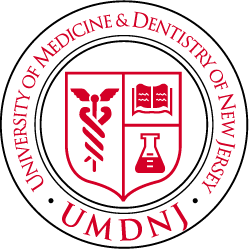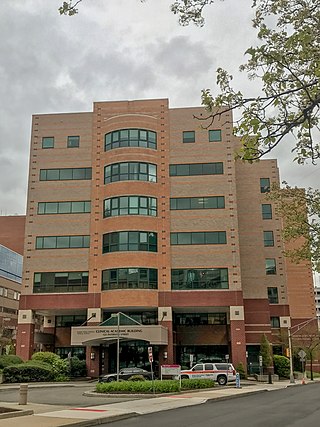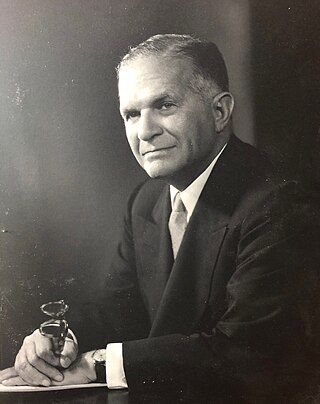
Rutgers University, officially Rutgers, The State University of New Jersey, is a public land-grant research university consisting of four campuses in New Jersey. Chartered in 1766, Rutgers was originally called Queen's College, and was affiliated with the Dutch Reformed Church. It is the eighth-oldest college in the United States, the second-oldest in New Jersey after Princeton University, and one of nine U.S. colonial colleges that were chartered before the American Revolution.

The University of Medicine and Dentistry of New Jersey (UMDNJ) was a state-run health sciences institution of New Jersey, United States.

University Heights is a neighborhood in Newark in Essex County, in the U.S. state of New Jersey. It is so named because of the four academic institutions located within its boundaries: Rutgers University, New Jersey Institute of Technology (NJIT), New Jersey Medical School (Rutgers) and Essex County College. In total, the schools enroll approximately 32,000 degree-seeking students.

NYU Grossman School of Medicine is a medical school of New York University, a private research university in New York City. It was founded in 1841 and is one of two medical schools of the university, with the other being the Long Island School of Medicine. NYU Grossman School of Medicine is part of NYU Langone Health, named after Kenneth Langone, the investment banker and financial backer of The Home Depot.

Rutgers Robert Wood Johnson Medical School is a medical school of Rutgers University. It is one of the two graduate medical schools of Rutgers Biomedical and Health Sciences, together with New Jersey Medical School, and is closely aligned with Robert Wood Johnson University Hospital, the medical school's principal affiliate.

Busch Campus is one of the five sub-campuses at Rutgers University's New Brunswick/Piscataway area campus, and is located entirely within Piscataway, New Jersey, US. Academic facilities and departments centered on this campus are primarily those related to the natural sciences: physics, pharmacy, engineering, psychology, mathematics and statistics, chemistry, geology, and biology. The Rutgers Medical School was also built on this campus in 1970, but a year later was separated by the state, renamed the Robert Wood Johnson Medical School, and merge with the New Jersey Medical School and other health profession schools in Newark and New Brunswick to create the College of Medicine and Dentistry of New Jersey. Rutgers and the medical school continued to share the land and facilities on the campus in a slightly irregular arrangement. On July 1, 2013, Robert Wood Johnson Medical School was officially merged back into Rutgers University, along with most of the other schools of UMDNJ, with the exception of the UMDNJ-School of Osteopathic Medicine.
New Jersey Medical School (NJMS)—also known as Rutgers New Jersey Medical School—is a medical school of Rutgers University, a public research university in Newark, New Jersey. It has been part of the Rutgers Division of Biomedical and Health Sciences since the 2013 dissolution of the University of Medicine and Dentistry of New Jersey. Founded in 1954, NJMS is the oldest school of medicine in New Jersey.
Jorge Benach is a medical researcher at the Stony Brook University in New York state. Benach is the chair of the Department of Molecular Genetics and Microbiology. Benach's main area of research is the tick-borne spirochete Borrelia burgdorferi, which is the causative agent of Lyme disease.

The College of Biological Sciences (CBS) is one of seven freshman-admitting colleges at the University of Minnesota. Established in 1869 as the College of Science, the College of Biological Science is now located across both the Minneapolis and the St. Paul campuses. The current interim dean is David Greenstein.
The Rutgers School of Dental Medicine is the dental school of Rutgers University. It is one of several professional schools that form Rutgers Biomedical and Health Sciences, a division of the university. Established in 1956, the dental school is located in the University Heights neighborhood in city of Newark, New Jersey, United States. It is the only dental school in New Jersey and is one of only two public dental schools in the New York metropolitan area.

University Hospital is an independent, state owned, teaching hospital in Newark, New Jersey that provides tertiary care to Northern New Jersey. The hospital is certified by the American College of Surgeons and is a state-designated Level 1 Trauma Center, one of only three in New Jersey.
Kenneth Breslauer is the Linus C. Pauling Distinguished Professor of Chemistry and Chemical Biology at Rutgers University. He is the Founding Dean of the Division of Life Sciences and served as vice president for Health Science Partnerships. Kenneth Breslauer's research focuses on defining and characterizing the molecular forces that control communication between biological molecules, particularly those interactions that modulate and control gene expression, DNA damage repair, mutagenesis, and drug binding. Breslauer arrived at the university as an assistant professor in 1974.
Paul James Lioy was a United States environmental health scientist born in Passaic, New Jersey, working in the field of exposure science. He was one of the world's leading experts in personal exposure to toxins. He published in the areas of air pollution, airborne and deposited particles, Homeland Security, and Hazardous Wastes. Lioy was a professor and division director at the Department of Environmental and Occupational Health, Rutgers University - School of Public Health. Until 30 June 2015 he was a professor and vice chair of the Department of Environmental and Occupational Medicine, Rutgers University - Robert Wood Johnson Medical School. He was deputy director of government relations and director of exposure science at the Rutgers Environmental and Occupational Health Sciences Institute in Piscataway, New Jersey.
Rutgers Biomedical and Health Sciences (RBHS) is the umbrella organization for the schools and assets acquired by Rutgers University after the July 1, 2013 breakup of the former University of Medicine and Dentistry of New Jersey. While its various facilities are spread across several locations statewide, Rutgers Biomedical and Health Sciences is considered the university's fourth campus.

Alice M. Lazzarini is a scientist, author and researcher on neurogenetic disorders, including Huntington's disease and Parkinson's disease. She is an assistant professor of Neurology at Rutgers Robert Wood Johnson Medical School, where her work helped establish the genetic basis of Parkinson's. Later in life, she was diagnosed with Parkinson's—the very disease she had spent decades researching.

Stanley Silvers Bergen Jr. was an American physician, healthcare educator and administrator, and university president. In 1971, he became the founding president of the incipient College of Medicine and Dentistry of New Jersey which he developed into the University of Medicine and Dentistry of New Jersey (UMDNJ) serving at its helm until his retirement in 1998. While he was president, UMDNJ became the nation's largest public health and science university, home to three medical schools and several allied medical health facilities.

David Melville Heyman was an American financier, health services leader, philanthropist, and art collector. Heyman founded the Public Health Research Institute of the City of New York in 1942 and the Health Insurance Plan of Greater New York in 1944, and served as the president of the New York Foundation for thirty years.
Ralph S. Muckenfuss served as the first director of The Public Health Research Institute of The City of New York; he left temporarily during World War II "to take up important duties with the American armed forces."
James M. Oleske is an American pediatrician and HIV/AIDs researcher who is the emeritus François-Xavier Bagnoud (FXB) Professor of Pediatrics at Rutgers New Jersey Medical School in Newark, New Jersey. He is best known for his pioneering work in identifying HIV/AIDS as a pediatric disease, and treating and researching it beginning in the 1980s. He published one of the first articles identifying HIV/AIDS in children in JAMA in 1983 and was a co-author of one of the articles by Robert Gallo and others identifying the virus in Science in 1984.










